Nano-JASMINE
Non-EO
JAXA
Astronomy and Telescopes
Quick facts
Overview
| Mission type | Non-EO |
| Agency | JAXA |
Nano-JASMINE (Nano Japan Astrometry Satellite Mission for INfrared Exploration)
Nano-JASMINE is a technology demonstration nanosatellite and a precursor mission of the Japanese JASMINE (Japan Astrometry Satellite Mission for INfrared Exploration) mission of NAOJ (National Astronomical Observatory of Japan) and JAXA planned for launch in 2014. JASMINE is to measure in the NIR spectrum (0.9 µm) distances and apparent motions of stars in the bulge of the Milky Way with yet unprecedented precision. It will measure parallaxes and positions with an accuracy of ≤ 10 µarcsec and proper motions with an accuracy of ≤ 4 µarcsec/year for stars brighter than z=14 magnitude.
Since JASMINE is requiring newly developed technology for its precise observations, NAO proposed a low-cost precursor technical demonstration satellite project, namely Nano-JASMINE. In this setup, NAOJ selected ISSL (Intelligent Space Systems Laboratory) of the University of Tokyo as its cooperative partner to develop the spacecraft. ISSL, which has experience in short-term development of small satellites, is in charge the of bus part, the ground segment development, and system integration. NAOJ is responsible for the observation equipment and mission data analysis. 1) 2) 3) 4) 5) 6) 7) 8) 9) 10)
The Nano-JASMINE mission objective is to measure the 3D positions of stars to an accuracy of 1.8 mas (milliarcsecond) by triangulation and acquires information about the stars. In order to acquire astrometry data for the entire celestial globe, Nano-JASMINE must operate in observation mode for more than 90% of the mission duration.
Demonstration/validation of new observation equipment
For astrometry observations, a beam-combiner is attached on the telescope. This is the key component which guarantees the accuracy of the measurement. The mirror surface planes and its cross angle stabilization will be tested on orbit (Figure 12).
Also, a new type of a FDCCD (Full-Depletion CCD) is developed for JASMINE. Nano-JASMINE is using this new CCD in TDI (Time Delay Integration) observation mode (a cumulative exposure concept for CCD imaging which integrates a pixel's electron charges to suppress the readout noise) to test its characteristics in space (deterioration data will be collected).
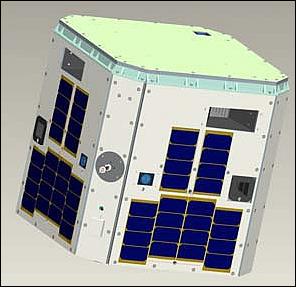
Note: Although Nano-JASMINE is an astrometry mission, a description of the mission was considered suitable also for the eoPortal due to the various spacecraft technology introductions (e.g., CCD operation, precise attitude control, precise thermal control, telescope) on a microsatellite which should be of general interest for the entire space community.
Spacecraft
Nano-JASMINE will carry a small size telescope as its payload which requires precise attitude control at ±1 arcsec precision. This is indeed a challenging problem for current small satellites. New attitude control devices and control algorithms are being developed to comply with this requirement. As for the thermal control, there are also strict requests from the infrared CCD cooling and the beam-combiner thermal stability at a level of 1 mK. 11)
Spacecraft size | Almost a cube with an envelop of 508 mm x 508 mm x 512 mm (separation mechanism is not included) |
Spacecraft mass | ~35 kg (separation mechanism is not included) |
Attitude control | - 3-axis stabilization with a pointing accuracy of 1.8 milliarcsecond (mas) |
Power generation | Peak power tracking |
Rf communications | S-band with an uplink data rate of 1 kbit/s and a downlink rate of 100 kbit/s |
Orbit | Sun-synchronous (at any LTAN) |
Mission life | 2 years |
Going by its size and mass Nano-JASMINE is a microsatellite! The design of the spacecraft structure must provide sufficient stiffness in support of high attitude stability as well as a large outer surface area for solar cell mounting. A symmetric structure is preferable to minimize any disturbance torques caused by air drag and solar wind pressure. Also, a long light shielding rod is needed to absorb the stray light for the telescope. These requirements call for a relatively large spacecraft platform with a low density.
Figure 2 shows the block diagram of the Nano-JASMINE system. Use of MicroBlaze processors which are configured in a Virtex-5 FPGA system. Two Virtex-5 FPGAs are installed for the Bus and Mission systems, each system features three MicroBlaze processors. A PIC (Peripheral Interface Controller) processor, which is more reliable for the radiation environment of space, monitors the main processor. 12)
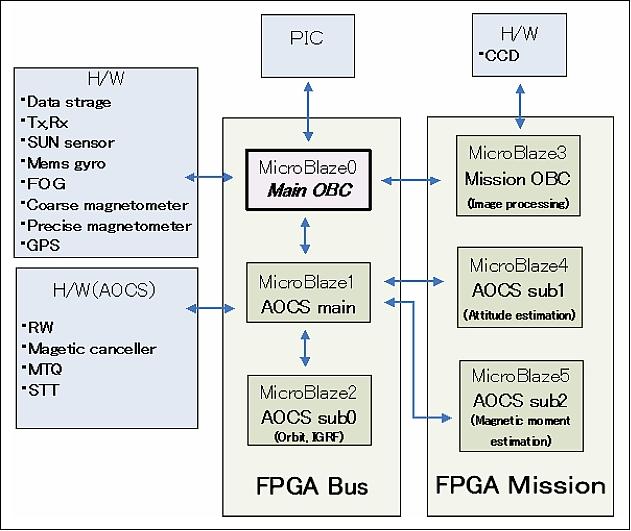
AOCS (Attitude and Orbit Control Subsystem): Table 2 shows the component specifications of the AOCS sensors and actuators. Nano-JASMINE stabilizes its attitude step by step using more precise attitude sensors and actuators. Therefore, several attitude modes are defined for the step-by-step attitude stabilization. 13)
Component | Value | Comment |
STT (Star Tracker) | Accuracy: 50 arcsec | Two STTs are mounted in the X- and Y-axes |
FOG (Fiber-Optic Gyroscope) | Accuracy : 1.0 x 10-6 rad/s | Three-axes FOG |
MEMS gyro | Accuracy : 1.0 x 10-3 rad/s | Three-axes gyro |
Sun sensor | Accuracy: 1.0º | Two-axes sun sensors installed in each panel |
Coarse magnetometer | Accuracy: 500 nT | For attitude determination, three-axes magnetometer |
Precise magnetometer | Accuracy: 100 nT | For RMM estimation, three-axes magnetometer |
MTQ (Magnetic Torquer) | 2.5 Am2 (max) | Three-axes magnetic torquer |
RW (Reaction Wheel) | Angular momentum: 1.0 x 10-4 rad/s | Four skewed reaction wheel configuration |
MC (Magnetic Compensation) | 0.6 Am2 (max) | For compensation of the magnetic disturbance |
GPS receiver |
| Provision of onboard time and orbit position |
Mode | Accuracy to be achieved | Sensor | Actuator |
Initial | 1.0 x 10-2 rad/s | Magnetometer | MTQ |
Coarse control | 1.0 x 10-3 rad/s | MEMS gyro | MTQ |
10º | Magnetometer, Sun sensor | ||
Unloading | 1.0 x 10-5 rad/s | Magnetometer, FOG | RW, MTQ, MC |
10º | STT | ||
Precise control | 1.0 x 10-5 rad/s | FOG | RW, MC |
0.05º | STT | ||
| X- and Y- axis: |
|
|
Z-axis: 840 mas while 9.9 sec |
Precise angular rate estimation from star images
During the observation mode, Nano-JASMINE estimates the angular rate using blurred star images from a telescope to satisfy the very hard requirements. Figure 3 shows the relationship between the motion of the satellite and the star images. Star images have only the information of angular rate magnitude, not the information of the angular rate sign. The first approach to get the information of the angular rate sign was to use measurements from FOG. However, the error of FOG is too large to use these measurements during an observation mode. This section shows another approach to get the angular rate direction.
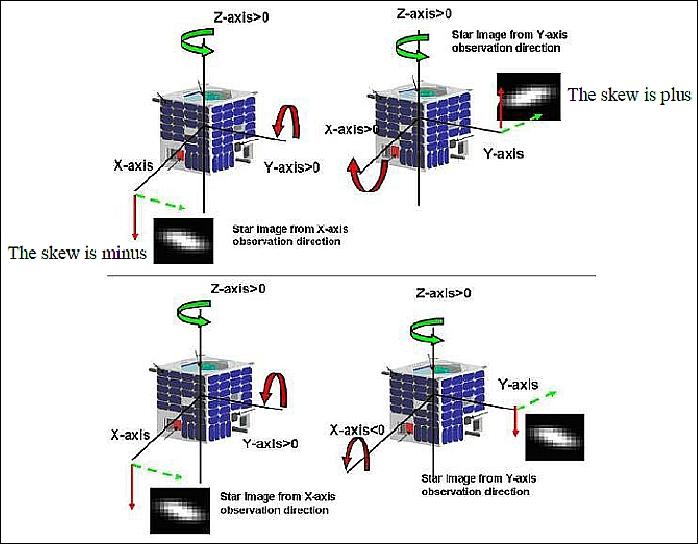
1) Magnitude of angular rate: The magnitude of the angular rate can be estimated by the variance of LSF (Line Spread Function), which is calculated using the star image measurements. Figure 4 shows a star image and its LSF. If the satellite rotates with an angular rate different from the TDI (Time Delay Integration) scanning rate, the star images will be blurred in the direction according to the axis of the rotation. Since the TDI scanning direction is designed to rotate around the Z-axis, the difference of angular rate in the Z-axis blurs the star images in the TDI direction and that in X- or Y-axis blurs them in the orthogonal to the TDI direction. In consequence, the variances of LSF for the X- or Y-axis and Z-axis are changed depending on the angular rate of each axis.
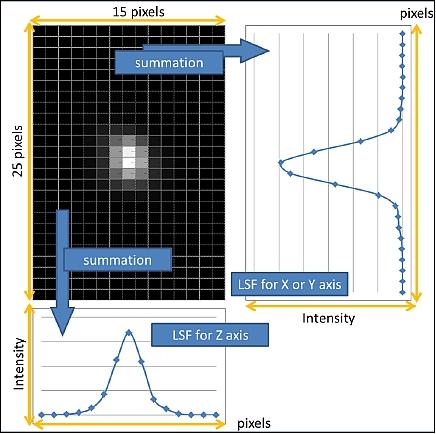
From the simulation results, the angular rate of the satellite and its variances (σ2 D) has the following relationship :

where D corresponds to the axis in the image, A is a proportionality factor determined from the exposure time, CD is a bias, it is a function of the exposure time and the wave length of the stars, and ω is the angular rate of the satellite. The observation accuracy of the angular rate becomes worse when the satellite is stabilized because the relationship is expressed as a quadratic function, and the sensitivity is smaller than noises around the zero angular rate. Therefore the satellite must control the angular rate with small offset rate, but this offset rate impairs the observation accuracy of star centroid. The satellite must choose appropriate offset rate to satisfy the observation requirements.
2) Sign of angular rate and observation direction: The above equation implies, that there is no information of an angular rate sign in the star images. Furthermore, Nano-JASMINE has two observation directions, and the star images come from two directions onto a single field of view through the beam combiner mirror. Therefore, the satellite must estimate the sign of the angular rate and which direction (X or Y) a star comes from. The sign of angular rate and the observation direction are not estimated individually. However, there are some relationships between them, if the sign of the angular rate in X- and Y-axes plane are equal. Table 4 shows these relationships. Where, “skew” is the direction of the inclination of star images. If star image is inclined upper right, its skew is plus like Fig 4. If the satellite knows the true sign of angular rate, the observation direction is estimated completely. In addition, if the satellite knows the true observation direction and true sign of angular rate in X- or Y-axes, the sign of angular rate in Z-axis is estimated completely.
ωx, ωy | + | - | ||||||
ωz | + | - | + | - | ||||
Skew | + | - | + | - | + | - | + | - |
Observation direction | Y | X | X | Y | X | Y | Y | X |
3) Angular rate estimation filter using star images: Figure 5 shows the flow chart of the method about the angular rate estimation using the star images from a mission telescope.
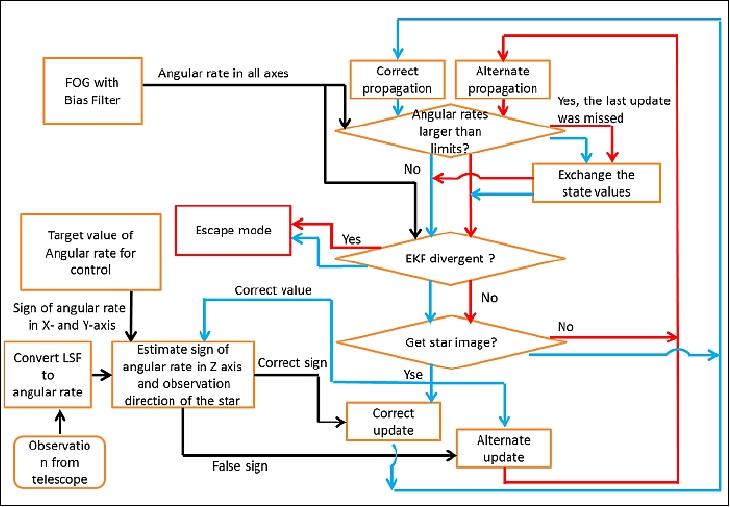
• Architecture of the star image EKF (Extended Kalman Filter): Nano-Jasmine uses the EKF method to estimate the angular rate from the star images. The state variables of the EKF are the angular rate, and the observations are the angular rate calculated by variances of the star LSF. When the satellite calculates the observation value, the sign of angular rate in all axes and the observation direction is needed. The sign of angular rate in the X- and Y-axis is determined from the observation value of the FOG or the target value for control, which is switched according to the mode described hereafter. The sign in the Z-axis is estimated from the difference between the estimated state value and the observed value. After that the observation direction (X or Y) is determined from the sign of the angular rate and the skew of the star images.
These processes are often aborted because of disturbances or of miss-modeling. Therefore, the satellite uses another EKF which is the same formation with the EKF described above, but the assumption of sign of angular rate in the Z-axis and the observation direction are different. And the satellite chooses which EKF is more suitable and uses the better state valuables for control and the following update. The criteria of judgment are the output of the FOG. If the satellite uses the state variables of the not so suitable EKF for control, then the angular rate of the satellite becomes larger than the one which the FOG can detect. This strategy is called “state variable exchange”.
• The observation mode and the escape mode: Whenever the EKFs do not converge, the satellite will be switched to the escape mode defined as in Table . In the escape mode, the satellite estimates the angular rate from star images, but does not use it for control; instead, the result of another rough Kalman Filter's output is used. Furthermore, the satellite selects the offset rate larger than the accuracy of the FOG as outlined in Table 5, and uses the FOG information to estimate the angular rate in the X- and Y-axis. The important point is that the satellite sets the offset rate in the X-axis, which is different from that in the Y-axis. Because of this, the satellite can estimate the observation direction completely, since the angular rate is different in the X- and Y-axis hereafter, and the satellite can estimate the sign of the angular rate in the Z-axis finally from the observation direction. Therefore, the EKF results will quickly converge and the satellite may be switched quickly to the observation mode.
In the observation mode, the satellite estimates the angular rate from the star images and uses it for control and sets the offset rate smaller than the requirements given by the mission side. The important point of this mode is using the target value to determinate the sign of the angular rate in the X- and Y-axis, because the angular rate of the satellite is too small to detect it when using the FOG measurements.
Parameter | Observation mode | Escape mode |
Transition condition | When the star image and EKF converge | The angular rate from the FOG observation is larger than the threshold value |
Target variable in X-axis | ±0.9 x 10-6 rad/s | ±3.0 x 10-6 rad/s |
Target variable in Y-axis | ±0.9 x 10-6 rad/s | ±2.0 x 10-6 rad/s |
Target variable in Z-axis | ±3.0 x 10-7 rad/s | ±1.6 x 10-6 rad/s |
Variables used in control | Output variables of star image EKF | Output variables of another rough EKF |
Sign estimation method | X- and Y-axes: determined from the target variables | X- and Y-axes: determined from the FOG measurement |
• A conventional information processing style with a main OBC (Onboard Computer) is adopted in support of all spacecraft functions. The OBC is based on a FPGA (Field Programmable Gate Array) implementation with the following services:
- A/D conversion of CCD output
- TDI clock control to synchronize with satellite spin
- Star image cutout from continuing CCD output for data compression.
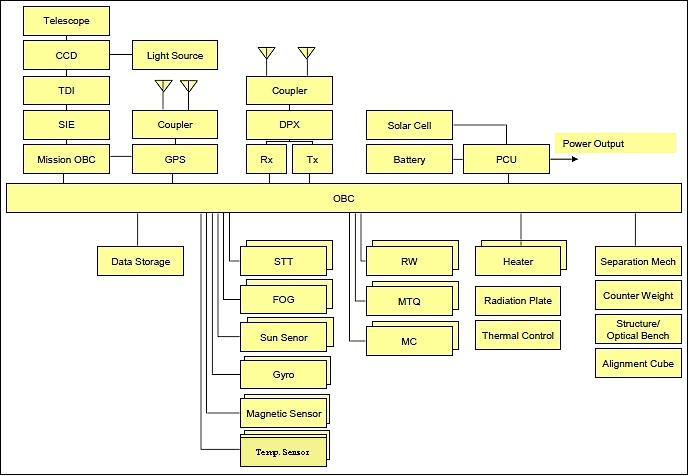
• The C&DH (Command & Data Handling) subsystem is centralized using a CPU core embedded FPGA (an FPGA implementation offers an improved radiation hardness over conventional CPUs in space). The FPGA provides a computing power of up to 100 MIPS. In Nano-JASMINE a typical centralized information processing style is adopted. The attitude control logic is installed to the main OBC which collects data from mission components and then sends commands to the mission OBC and actuators.
• TCS (Thermal Control Subsystem): The following requirements apply to the control of the thermal subsystem:
- The beam-combiner angle calls for a stability of ±≤ 1mas per two orbit periods. This is equivalent to a temperature stability of ±≤ 1 mK. This angle guarantees the measurement accuracy.
- The telescope frame temperature stability must be within 1 K to be in focus.
- The CCD unit must be kept at a temperature of ≤ -50ºC for infrared detection.
Temperature stability is achieved by covering the telescope with a thermal shield. The telescope and the shield are held by adiabatic columns which block any transfer of heat (also release of heat stress). The CCD is cooled by the effect of thermal emissions from a radiation plate on the top of satellite. However, this estimation is difficult due to orbit uncertainty, and the radiation plate is inevitable to see the Earth occasionally because of the observation method (Figure 7).
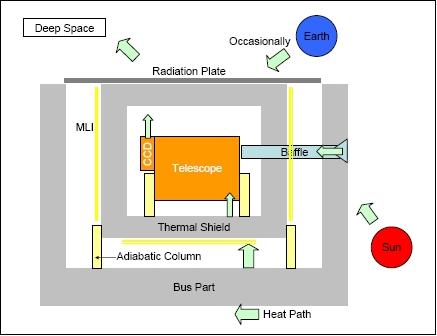
• RF communication subsystem: Use of S-band, the uplink data rate is 1 kbit/s (modulation = PCM-PSK-PM); the downlink data rate is nominally 100 kbit/s with a BPSK modulation. The transmit power is 0.2 W, the receive power is 1 W.
The onboard antenna is a backfire helical type where uplink and downlink share the same device. The Earth pointing side antenna is the main one used for transmissions. In addition, a second antenna is mounted on the opposite side of the spacecraft (for lost case support) which is branched by a 10 dB coupler.

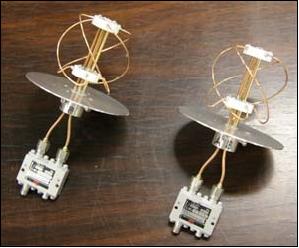
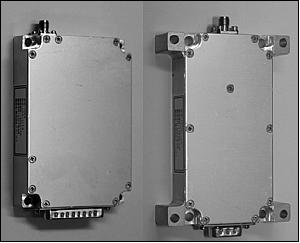
• EPS (Electric Power Subsystem): The EPS is of ISSL bus heritage. It uses surface mounted GaAs solar cells, a Li-ion battery, and peak power tracking. The power control unit and the OBC mutually monitor each other to respond for single event effects. The spacecraft power generation is estimated to be 20 W.

Launch
A launch as a secondary payload of Nano-JASMINE is now scheduled for 2015 from the Alcantara Launch Center, Brazil. The launch vehicle is a Cyclone-4 of SDO Yuzhnoye, Ukraine. 16)
Note: On February 26, 2010, the University of Tokyo, NAOJ (National Astronomical Observatory of Japan), Alcantara Cyclone Space, and SDO Yuzhnoye (Ukraine) reached an agreement to launch Nano-JASMINE by a Cyclone-4 (also spelling of Tsyklon-4) rocket from the Alcantara Launch Center, referred to as CLA (Centro de Lançamento de Alcântara) in Brazil. - In July 2003, Brazil struck a deal with Ukraine under which Alcantara will be the host station for launches of that country's Cyclone rockets. 17) 18) 19)
The ACS (Alcântara Cyclone Space) binational company, is responsible for the commercialization and operation of launch services using the Cyclone-4 launch vehicle from its launch site in Alcântara.
Orbit: Sun-synchronous orbit, altitude range: 800 km.
Sensor Complement
Astrometry is a field of observational astrophysics that measures positions and motions of stars on the celestial sphere and determines the distances to them using trigonometric parallaxes due to Earth orbit around the sun. For astrometry, space telescopes have much more advantage than those on the ground because the atmosphere crucially disturbs the measurements. - The Hipparcos spacecraft of ESA (1989-1983) was the only astrometry mission so far which provided an all-sky observation of stars (~ 100,000) with an angular accuracy of 1 mas (milliarcsecond). Hipparcos had a launch mass of ~ 1400 kg which is two orders of magnitude greater than that of the Nano-JASMINE mission.
Telescope
The objective is to measure absolute positions of bright stars (z ≤ 8 magnitude) with accuracies about a few milliarcseconds in a few years of mission life. Nano-JASMINE uses a Ritchey-Chretien type telescope with reflecting optics and three flat mirrors (the light path after the 2nd mirror is folded by the plane mirrors). The effective diameter of the telescope is 5 cm. The requirements of the small telescope call for a diffraction-limited performance. A Ritchey-Chretien type telescope was selected. 20) 21) 22) 23) 24) 25)
The telescope features a special flat mirror, called beam-combiner, two flat mirror positioned at different angles in front of primary mirror. The beam-combiner is used for global field astrometry whose basic angle is 99.5º, so that the apparent relative distribution of stars can be resolved into a satellite's motion and an actual distribution of stars.
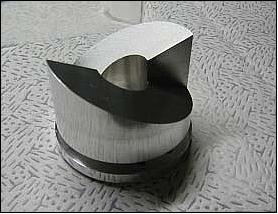
The optical axes of the beam-combiner are perpendicular to spin axis of satellite. The telescope will then scan all-sky along a great circle. This technique enables the project to resolve between an irregularity in the spin motion of satellite and the distribution of stellar positions.
All mirrors and their structural supports are manufactured of aluminum alloys using ultra-precise machinery and tools. Moreover, the reflecting surfaces of the mirrors are physically deposited with Cr and Au vapor. The total performance of the telescope is measured with an interferometer.
The imaging observation of the celestial object using the Nano-JASMINE telescope is conducted with a CCD of Bitran Corporation of Japan. Different from the Hipparcos era, the Nano-JASMINE project uses CCD detectors whose quantum efficiency is about 90%.
The optical layout of Nano-JASMINE telescope is shown in Figure 13. Though, the beam-combiner should appear around the secondary, it is omitted in this Figure. This telescope is based on a Ritchie-Chretien type telescope and consists of beam-combiner, two hyperboloid mirrors and three flat mirrors. The three flat mirrors are mounted to bend the optical path after the secondary mirror (M2) into a compact volume. The effective diameter of primary mirror (M1) is 5 cm. The focal length is determined from the diffraction size that fits the lengths of four pixels at the focal plane. The relative angle of beam-combiner is set to 99.5º, so that an apparent relative distribution of stars can be resolved into a satellite spin motion and an actual distribution of stars.
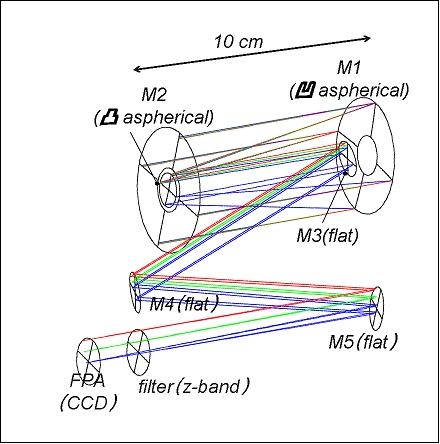
SIE (Star Image Extractor)
The project developed a SIE device which works as an on-board real-time image processor. SIE features a logic circuit written on an FPGA device. It detects and extracts only an object data from raw image data. 26)
TDI is one of operation modes of the CCD detector. Data is obtained, by rotating the imaging system, including the CCD, at a rated synchronization with a vertical charge transfer of the CCD detector.
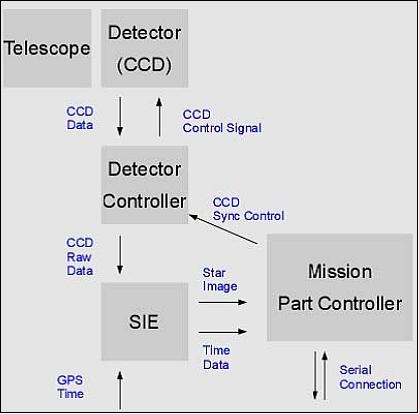
Aperture diameter (M1) | 5 cm (divided into two by a beam-combiner) |
Focal length | 167 cm (f/33), use of folded optics |
Optics system | Ritchey-Chretien type, with 2 aspherical mirrors and 3 folding mirrors |
FOV (Field of View) | 0.5º x 0.5º |
Basic angle | 99.5º |
Wavelength range | zw-band (600 -1000 nm) |
Detector | - FDCCD (Full-depletion CCD), 2 k x 1 k pixels, with TDI (Time Delay Integrator) operation |
Pixel scale | 15 µm (1.76 arcsec/pixel) |
Operating temperature | -50ºC to ~ 100ºC |
Telescope mass, size | 1.7 kg, 17 cm x 12 cm x 12 cm |
The operating temperature of the telescope is around 220 K, being optimized for the CCD detector.
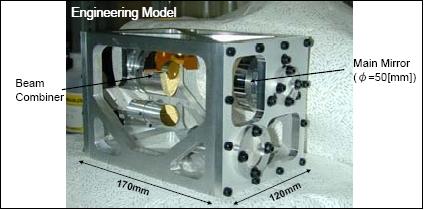
In 2008, a series of performance tests and numerical analysis were already conducted and its results indicated the telescope of Nano-JASMINE has enough performance capability for scientific astrometry.
Ground Segment
The Nano-JASMINE ground segment consists of three antennas and two control centers as shown in Figure 16. Nano-JASMINE is basically operated only during passes above Japan. Each ground station and control room is connected via network; the data is shared. 27)
• The ground station of ISSL (Intelligent Space Systems Laboratory) features a 3 m dish antenna on the campus of Tokyo University. The antenna is used to provide the monitor and control services for the spacecraft. It can be used for uplink and low speed (10 kbit/s) downlink.
• The Mizusawa ground station of NAOJ features a 10 m antenna dish. It is being used to receive the science data of Nano-JASMINE. The antenna can receive low and high-speed (100 kbit/s) downlink data.
• In addition, an overseas station (Kiruna) will be used to provide its services during the initial acquisition and operations phase.
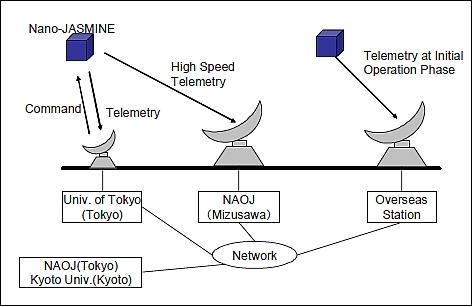
Operation strategy: An overview of the mission sequence is shown in Figure 17.
• Initial checkout: The first few days are used for satellite survival. Then preliminary functions such as high speed telemetry are examined. Finally, advanced functions such as attitude control and its parameter estimation will be done. This work is expected to be done within two weeks.
• Mission equipment verification: The next two weeks the project will focus on mission part tests. Each component operation and calibration will be done. Continuous great circle survey under high attitude stabilization is the goal of this part.
• Observation: After the above tests, the astrometry observation will be continued for two years. Observation will be halted occasionally for satellite maintenance.
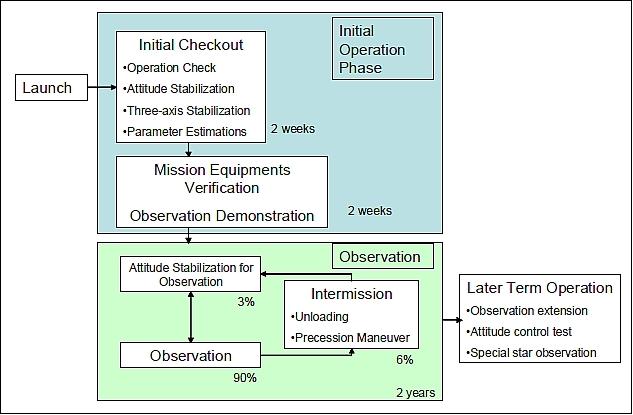
Stake holders and management of the mission: Organizations which are involved in Nano-JASMINE operation are shown in Figure 18. The Nano-JASMINE satellite development members are still responsible for its operation. In this case operation means to decide satellite tasks, control of ground station to establish link, data analysis and distribution.
Analyzed data is distributed to astrometry scientist all over the world. This distribution system is constructed in the mission side computer server. Special observation requests will be accepted. The Bus side is responsible for each ground stations’ coordination of use.
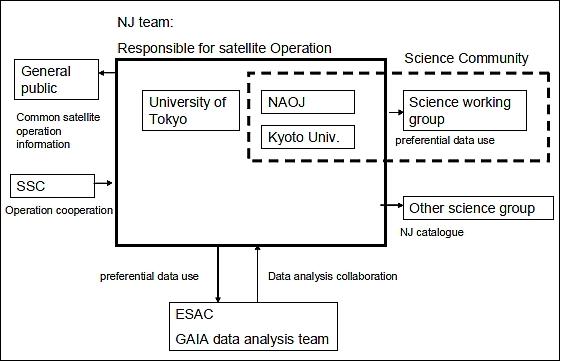
References
1) Nobutada Sako, Takaya Inamori, Kensuke Shimizu, Yoshinori MIkawa, Shinichi Nakasuka, “Development of Infrared Astrometry Satellite Nano-JASMINE Flight Model,” Proceedings of the 28th ISTS (International Symposium on Space Technology and Science), Okinawa, Japan, June 5-12, 2011, paper: 2011-h-01
2) N. Sako, Y. Hatsutori, T. Inamori, S. Nakasuka, “Small Infrared Astrometry Satellite Nano-JASMINE Bus System,” Proceedings of the 26th ISTS (International Symposium on Space Technology and Science) , Hamamatsu City, Japan, June 1-8, 2008, paper: 2008-f-21
3) N. Sako, Y. Hatsutori, T. Tanaka, T. Inamori, S. Nakasuka, “Nano-JASMINE: A Small Infrared Astrometry Satellite,” 21st annual AIAA/USU Conference on Small Satellites, Logan, UT, USA, Aug. 13-16,, 2007, SSC07-VI-4
4) Y. Kobayashi, N. Gouda, T. Tsujimoto, Y. Takuji, T. Yano, M. Suganuma, M. Yamauchi, N. Takato, S. Miyazaki, Y. Yamada, N. Sako, S. Nakasuka, “Memorie della Societa Astronomica Italiana,” Vol..77, 2006, p.1186
5) N. Gouda, T. Yano, Y. Yamada, Y. Kobayashi, T. Tsujimoto, and the JASMINE Working Group, “Japan Astrometry Satellite Mission for Infrared Exploration (JASMINE),” ESA RSSD (Research and Scientific Support Department), 2004, URL: http://www.rssd.esa.int/SA/GAIA/docs/Gaia_2004_Proceedings/Gaia_2004_Proceedings_77.pdf
6) T. Inamori, S. Nakasuka, “In-orbit magnetic disturbance compensation using feed forward control in Nano-JASMINE mission,” Proceedings of the 22nd Annual AIAA/USU Conference on Small Satellites, Logan, UT, USA, Aug. 11-14, 2008, SSC08-VIII-4
7) Yoichi Hatsutori, Naoteru Gouda, Yukiyasu Kobayashi, Taihei Yano, Yoshiyuki Yamada, “A very small satellite for space astrometry: Nano-JASMINE,” URL: http://www.ast.cam.ac.uk/iau_comm8/iau27/presentations/Hatsutori.pdf
8) Takaya Inamori. Shinichi Nakasuka, Nobutada Sako, “Attitude estimation using star images in Nano-JASMINE mission,” Proceedings of the 27th ISTS (International Symposium on Space Technology and Science) , Tsukuba, Japan, July 5-12, 2009, paper: 2009-d-13,
9) Yukiyasu Kobayashi, Taihei Yano, Naoteru Gouda, Yoshiyuki Yamada, Naruhisa Takato, Satoshi Miyazaki, Masahiro Suganuma, Seiji Ueda, Shin’ichi Nakasuka, and the JASMINE working group, “Nano-JASMINE: a nano size astrometry satellite,” Proceedings of the IAU Colloquium No. 196, 2004
10) N. Gouda and JASMINE Working Group, “Present status of JASMINE projects,” Commission 8 science meeting @ IAU GA28, 29 Aug. 2012, URL: http://www.ast.cam.ac.uk/ioa/iau_comm8/iau28/presentations/Gouda.pdf
11) Nobutada Sako, “About Nano-JASMINE Satellite System and Project Status,” Proceedings of the 27th ISTS (International Symposium on Space Technology and Science) , Tsukuba, Japan, July 5-12, 2009, paper: 2009-f-10
12) Satoshi Ikari, Nobutada Sako, Takaya Inamori, Kensuke Shimizu, Jun-ichi Takisawa, Takayuki Hosonuma, Takumasa Ochi, Ryuhei Hamaguchi, Miki Yonehara, Naoya Ozaki, Motoki Kimura, Satoshi Miyatani, Shinichi Nakasuka, “Development of a precise attitude determination and control system for the 35 kg astrometry satellite Nano-JASMINE,” Proceedings of the UN/Japan Workshop and The 4th Nanosatellite Symposium (NSS), Nagoya, Japan, Oct. 10-13, 2012, paper: NSS-04-0109
13) Takaya Inamori, Shinichi Nakasuka, “Attitude Control System for Arc-Second Stabilization of 30-kg Micro Astronomy Satellite,” Interplanetary CubeSat Workshop, Cambridge, MA, USA, May 29-30, 2012, URL: http://icubesat.files.wordpress.com/2012/06/icubesat-org-2012-c-3-5-_paper_inamori_201205291022.pdf
14) Takaya Inamori, “ Attitude stabilization using blurred star images for a nano-astrometry satellite mission,” AIAA Guidance Navigation and Control Conference, Portland,OR, USA, August 11, 2011. paper: AIAA 2011-6510
15) Takayuki Hosonuma, Takaya Inamori, Shinichi Nakasuka, “A Precise Attitude Determination and Control Strategy for Small Astrometry Satellite Nano-JASMINE,” Proceedings of the 26th Annual AIAA/USU Conference on Small Satellites, Logan, Utah, USA, August 13-16, 2012, paper: SSC12-VIII-2
16) Information provided by Shinichi Nakasuka of ISSL(Intelligent Space Systems Laboratory) at the University of Tokyo, Japan (June 2013).
17) [web source no longer available]
18) “Nano-JASMINE Satellite to be Launched by Cyclone-4 Rocket from Brazil,” URL: http://www.jasmine-galaxy.org/nano/080528-en.html
19) Yukiyasu Kobayashi, Naoteru Gouda, Taihei Yano, Yoichi Hatsutori, Yoshiyuki Yamada, Yoshito Niwa, Junpei Murooka, Nobutada Sako, Shin'ichi Nakasuka, “Nano-JASMINE Ready to Launch,” 2010, URL: http://www.nao.ac.jp/contents/about-naoj/reports/annual-report/en/2010/e_web_048.pdf
20) Yoichi Hatsutori, Yukiyasu Kobayashi, Naoteru Gouda, Taihei Yano, Yoshiyuki Yamada, Yoshito Niwa, “Development of 5cm reflecting telescope for Nano-JASMINE,” Proceedings of the 27th ISTS (International Symposium on Space Technology and Science) , Tsukuba, Japan, July 5-12, 2009, 2009-m-10,
21) Y. Hatsutori, M. Suganuma, Y. Kobayashi, N. Gouda, T. Yano, Y. Yamada, M. Yamauchi, “A Very Small Astrometry Satellite, Nano-JASMINE : Its Telescope and Mission Goals,” Proceedings of the 26th ISTS (International Symposium on Space Technology and Science) , Hamamatsu City, Japan, June 1-8, 2008
22) M. Suganuma, Y. Kobayashi, N. Gouda, T. Yano, Y. Yamada, N. Takato, Y. Yamauchi, “Aluminum-made 5-cm reflecting telescope for Nano-JASMINE,” Proceedings of. SPIE, 'Space Telescopes and Instrumentation I: Optical, Infrared, and Millimeter,' Editors: John C. Mather, Howard A. MacEwen, Mattheus W. M. de Graauw, Vol. 6265, 626545, Orlando, FLA, USA, May 24-31, 2006
23) Yoshito Niwa, Yoichi Hatsutori, Junpei Murooka, Yukiyasu Kobayashi, Naoteru Gouda, Taihei Yano, Yoshiyuki Yamada, “Performance evaluation of Nano-JASMINE telescope flight model,” Proceedings of the 28th ISTS (International Symposium on Space Technology and Science), Okinawa, Japan, June 5-12, 2011, paper: 2011-h-02
24) Y. Hatsutori, Y. Kobayashi, N. Gouda, T. Yano, J. Murooka, Y. Niwa, Y. Yamada, “Performance Evaluation of Nano-JASMINE,” EAS (European Astronomical Society) Publications Series, Vol. 45, 2010, pp. 397-400
25) O. Y. Hatsutori, Y. Kobayashi, N. Gouda, T. Yano, J. Murooka, Y. Niwa, “Performance evaluation of Nano-JASMINE,” ELSA (European Leadership in Space Astronomy) Conference 2010 – Gaia: at the frontiers of astrometry, Paris, France, June 7-10, 2010, URL: http://wwwhip.obspm.fr/gaia2010/IMG/pdf/Poster_Hatutori.pdf
26) Y. Yamada, M. Yamauchi, N. Gouda, Y. Kobayashi, T. Tsujimoto, T. Yano, M. Suganuma, S. Nakasuka, N. Sako, T. Inamori, “A Star Image Extractor for Small Satellites,” Proceedings of the 26th ISTS (International Symposium on Space Technology and Science) , Hamamatsu City, Japan, June 1-8, 2008
27) Nobutada Sako , Takaya Inamori, Kensuke Shimizu, Yoshinori Mikawa, Junichi Takisawa, Takayuki Hosonuma, Satoshi Ikari, Shinichi Nakasuka, “Astrometry Satellite Nano-JASMINE Ground Station System and its Operation Plan,” Proceedings of the 29th ISTS (International Symposium on Space Technology and Science), Nagoya-Aichi, Japan, June 2-8, 2013, paper: 2013-f-05
The information compiled and edited in this article was provided by Herbert J. Kramer from his documentation of: ”Observation of the Earth and Its Environment: Survey of Missions and Sensors” (Springer Verlag) as well as many other sources after the publication of the 4th edition in 2002. - Comments and corrections to this article are always welcome for further updates (eoportal@symbios.space).